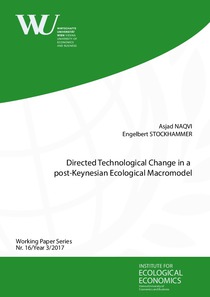Directed technological change in a post-keynesian ecological macromodel
"This paper presents a post-Keynesian ecological macro model that combines three strands of literature: the directed technological change mechanism developed in mainstream endogenous growth theory models, the ecological economic literature which highlights the role of green innovation and mater...
| Main Authors: | , |
|---|---|
| Institution: | ETUI-European Trade Union Institute |
| Format: | TEXT |
| Language: | English |
| Published: |
Vienna
2017
Vienna University of Economics |
| Subjects: | |
| Online Access: | https://www.labourline.org/KENTIKA-19394141124911123239-Directed-technological-change-.htm |
| Summary: | "This paper presents a post-Keynesian ecological macro model that combines three strands of literature: the directed technological change mechanism developed in mainstream endogenous growth theory models, the ecological economic literature which highlights the role of green innovation and material flows, and the post-Keynesian school which provides a framework to deal with the demand side of the economy, financial flows, and inter- and intra-sectoral behavioral interactions. The model is stock-flow consistent and introduces research and development (R&D) as a component of GDP funded by private rm investment and public expenditure. The economy uses three complimentary inputs - Labor, Capital, and (non-renewable) Resources. Input productivities depend on R&D expenditures, which are determined by relative changes in their respective prices. Two policy experiments are tested; a Resource tax increase, and an increase in the share of public R&D on Resources. Model results show that policy instruments that are continually increased over a long-time horizon have better chances of achieving a "green" transition than one-off climate policy shocks to the system, that primarily have a short-run affect." |
|---|---|
| Physical Description: | 40 p. Digital |

